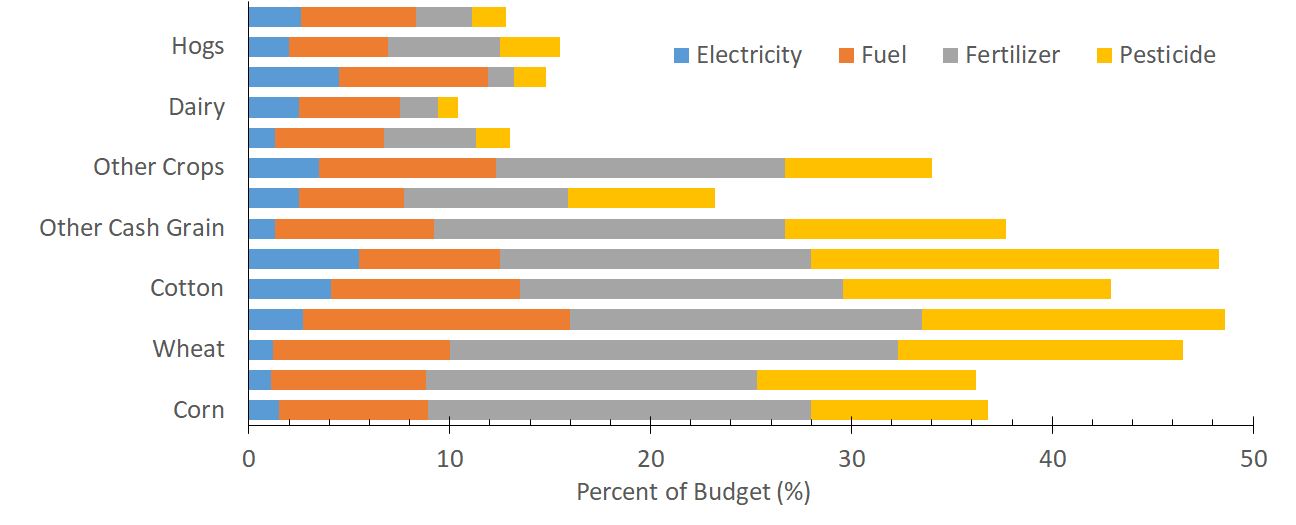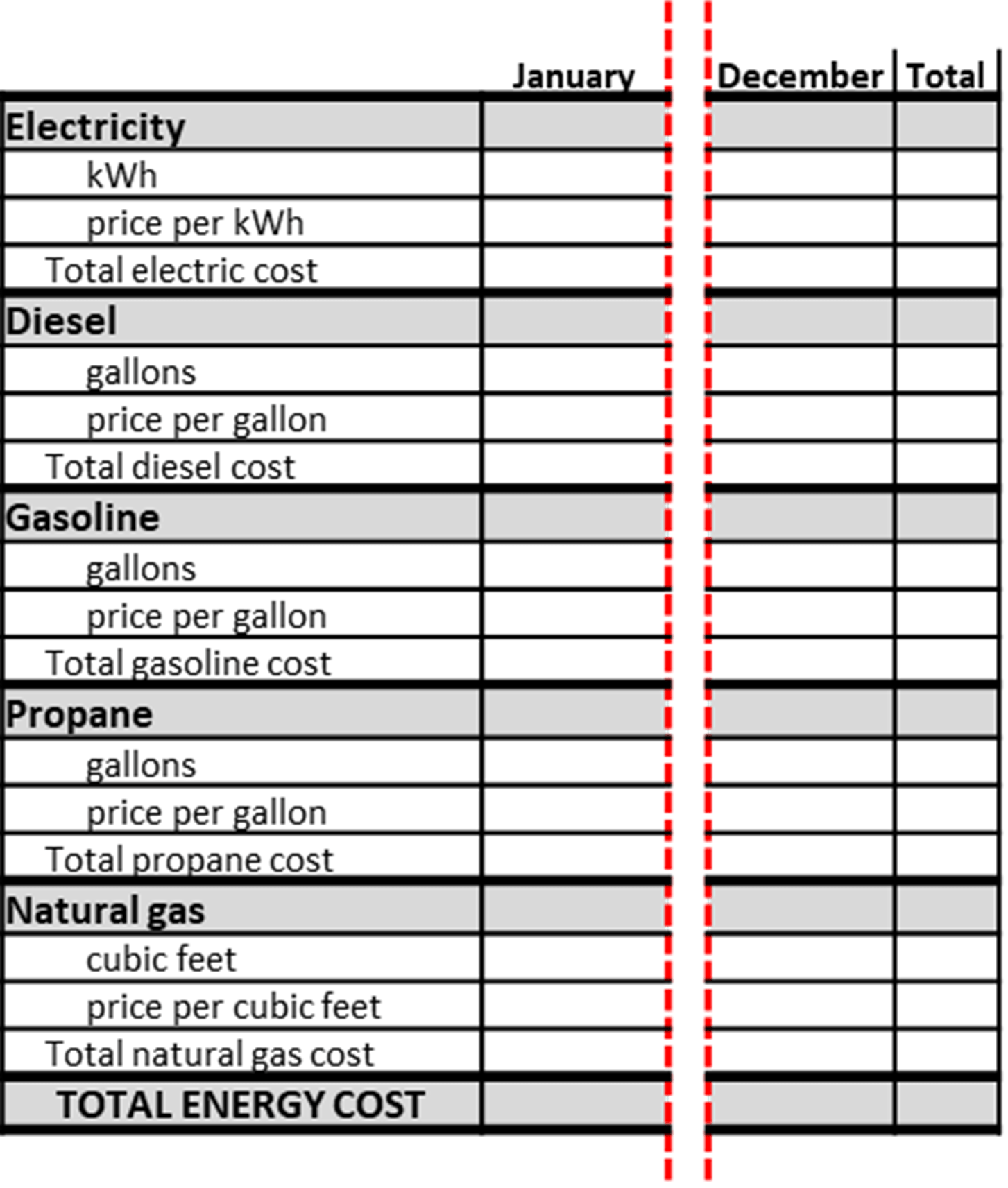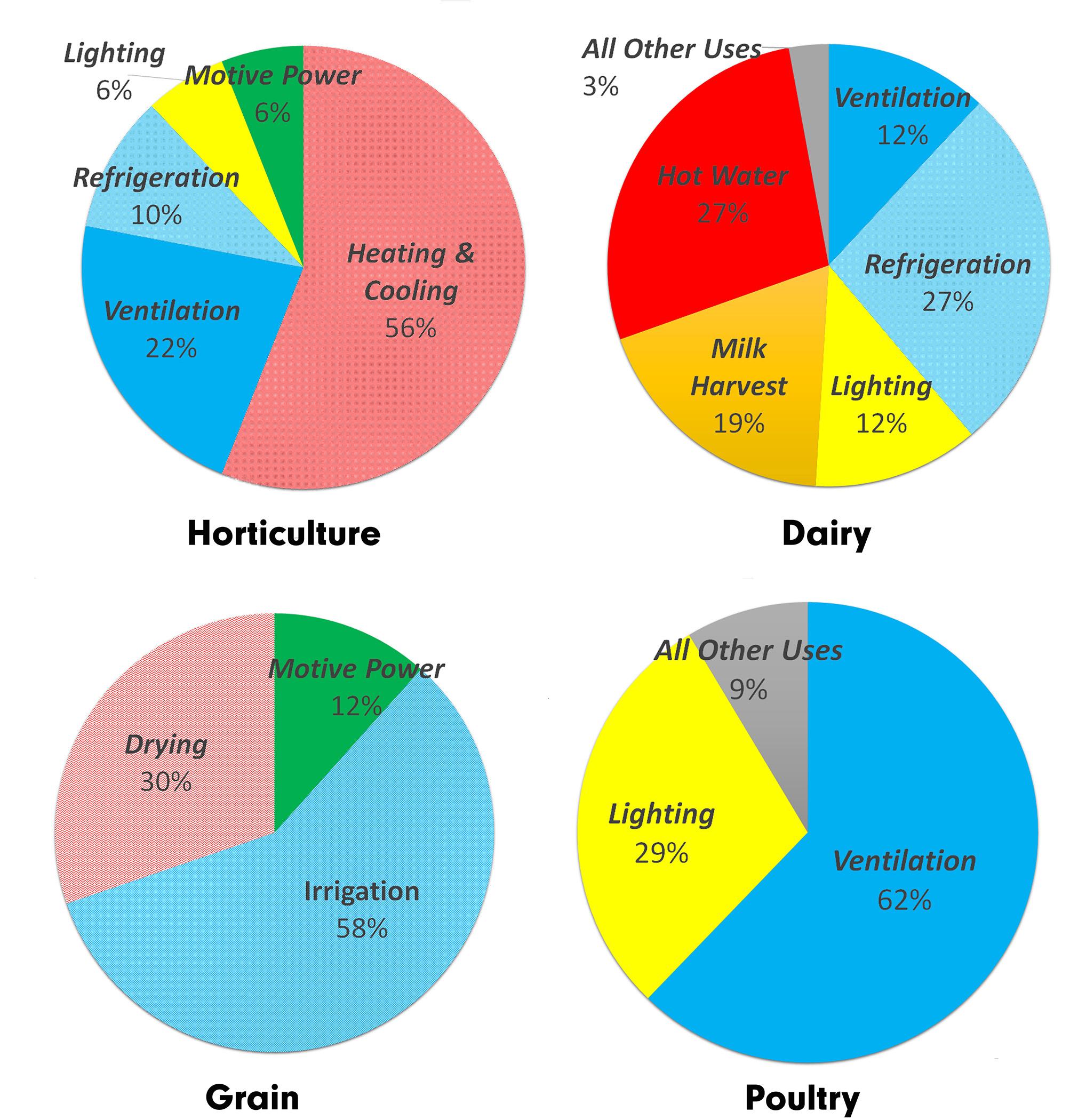
FS-1138 | September 2020
Understanding Farm Energy
The energy used to perform many tasks on crop and livestock operations may cost you several hundred or thousands of dollars each month. On average, fuel and electricity used for operating equipment account for 15% of U.S. agricultural production costs (see Figure 1). Farmers incur additional energy costs through purchases of petroleum-based products (i.e., fertilizer and pesticides) and commodity transportation expenses. Transportation costs are higher for more rural farms since products must travel farther to markets.
The cost of energy comes amidst growing concerns over low farm profits, rising energy prices in the agricultural sector (EIA, 2019), and Maryland’s rapidly changing energy environment. By 2030, for example, 50% of the state’s electricity must be generated from renewable energy sources. The greatest impact of the changing energy market is expected on farms using a lot of fuel for machinery and on smaller farms that are unable to distribute their energy costs across a large number of acres or number of livestock, due to the different economies of scale compared to larger farms.

How can I assess energy use on my farm?
An energy log is an easy and inexpensive method for tracking energy use on your farm based on your actual energy bills. The information you collect in the energy log can help you determine where energy inefficiencies are occurring on your farm and where improvements can be made. You can download a simple form from the UME website for use with Excel(TM) or you can print the form.
You can track the amount of energy used on your farm and its cost in the energy log by recording new information or by entering data from past bills.
- Electricity: Enter the number of kilowatts (kWh) used and the total cost for electricity from your electric utility bill. The cost per kWh will automatically be calculated.
- Diesel, gasoline, propane: Enter the gallons used and the total cost when you receive a bill from your service provider. Information may not be recorded for each month depending on the time of year and the amount used. The price per gallon will automatically be calculated.
- Natural gas: If your farm uses natural gas, enter the cubic feet and cost. The price per cubic foot will automatically be calculated.
- Total energy cost: The form will automatically calculate your year-end total use, cost for each energy input, and monthly total energy cost.

How much electricity do specific activities use?
While many fuels, such as diesel and propane, are easily related to their specific use on a farm, you will need the wattage rating (W) of each electric item when subdividing your total monthly electricity (kWh) into its different uses (Table 1). Lightbulbs are usually stamped with their wattage rating while other items such as motors use about 0.75 kW (750 W) per horsepower (hp).
Lighting ExampleFifty 100 W incandescent lights in a barn are turned on each morning at 7 am and turned off at 5 pm (10 hours/day). Assuming a cost of $0.08 per kWh, how much would you save by using the lights one hour each morning and one hour each evening (2 hours/day)? |
||||
| Power Used: | 50 lights | x 100 W/light | = 5,000 W | = 5.0 kW |
| Use (10 hr/day): | 5.0 kW | x 10 hr/day | = 30 day/mo | = 1,500 kWh |
| Use (2 hr/day): | 5.0 kW | x 2 hr/day | = 30 day/mo | = 300 kWh |
| Cost (10 hr/day): | 1,500 kWh | x $0.08/kWh | = $120.00/mo | |
| Cost (2 hr/day) | 300 kWh | x $0.08/kWh | = $24.00/mo | |
| Savings: | $120.00/mth | - $24.00/mo | = $96.00/mo | $1,152.00/yr |
Fan ExampleWhat is the monthly electrical use of a continuously running ventilation fan with a 1⁄2 hp motor? |
||||
| Power Used (hp): | 1⁄2 hp | x 0.75 kW/hp | = 0.375 kW | |
| Use (15 hr/day): | 0.375 kW | x 24 hr/day | x 30 day/mth | = 270 kWh |
| Cost (15 hr/day): | 270 kWh | x $0.08/kWh | = $21.60/mth | = $259.20/yr |
Grain Drying ExampleWhat does it cost to operate a 20-hp electric motor running a grain drying fan 15 hr/day for 24 days during the monthly billing period? |
||||
| Power Used: | 20 hp | x 0.75 kW/hp | = 15 kW | |
| Use (15 hr/day) | 15 kW | x 15 hr/day | x 24 day/mth | = 5,400 kWh |
| Cost (15 hr/day) | 5,400 kWh | x $0.08/kWh | = $432.00/mth | = $5,184.00/yr |
How do I start saving energy on my farm?
This report provides information on various opportunities for energy conservation (reduce energy demand) and energy efficiency (improve energy use) to improve the profitability and sustainability of farms in Maryland. While addressing specific farm operations requires detailed information, this publication highlights some of the common energy-consuming operations and introduces simple ways to conserve energy and improve efficiency. Taking steps toward better energy conservation and efficiency will help Maryland farms reduce energy costs and improve their financial returns.
While the energy used in specific farming enterprises is beyond the scope of this publication, several free and low-cost options are introduced to help farmers lower their energy expenses.

How can energy costs be reduced in buildings?
Service heating and cooling systems regularly: Replace air filters as necessary. Avoid heating or cooling unused areas, while setting temperatures in the more active areas at least several degrees cooler or warmer than your typical comfort level.
You should properly match equipment with the heating and cooling loads of the structure and adhere to site-specific recommendations for insulation. You can save additional energy by landscaping with a shelterbelt of trees to reduce the impact of cold winds during cooler seasons and provide shade in warmer weather. Insulate windows with clear plastic or install storm windows. Sealing air leaks with caulking and weatherstripping can also help reduce the heat transfer around windows and doors by up to 37% (Cosgrave and Campbell Smith, 2018).
Keep ventilation systems well-maintained: You can save additional energy while improving the quality of air within farm structures such as poultry and livestock housing. Natural ventilation can reduce heating and cooling needs when feasible, but circulating fans may further improve heat distribution if needed. Fans should also be serviced regularly and kept free from dust and debris.
Select lighting options for your farm facility based on safety and efficiency: Replacing incandescent bulbs with CFLs or LEDs may help reduce your monthly electric bill since they use about 74% and 84% less energy; respectively. High-intensity discharge lamps or metal halide lamps may be the most efficient option for larger areas on your farm. Timers, daylight sensors, and motion sensors also ensure that your lights are on only when needed.
Purchase refrigeration systems and other on-farm equipment that are energy efficient: Give special consideration to those systems carrying the ENERGY STAR® label and certification. Dairy farms, in particular, have many options including the use of plate coolers to reduce cooling times, refrigeration heat exchangers to preheat water, and variable frequency drives for varying loads such as milk pumps, vacuum pumps, and ventilation fans.
How can energy be managed in fields?
Drying grain in the field may save energy when feasible: Natural air or low-temperature mechanical drying may be necessary to preserve grain quality. In those cases, you can save energy by regularly cleaning the aeration system, sealing any leaks, and timing the aeration for maximum cooling.
Maintain field machinery to improve energy efficiency: Regularly replace filters, change the oil, keep tires inflated and balanced, and use the correct grade of fuel for the weather. You should also avoid unnecessary idling and reduce excess loads. Additional fuel savings are possible when combining multiple field tasks, using appropriately sized machines for each job, and periodically sharpening ground tillage implements. No-till or minimum-till planting can also save 3.5 gal of fuel per acre (Hitaj & Suttles, 2016; NRCS, 2005; Helsel, 2007), while responsible nutrient management can conserve fossil fuel-based fertilizers through regular soil testing, calibrated applications, legume planting, and manure management.
Irrigation is an energy-intensive part of farming: Irrigation can use anywhere from 2 to 40 gallons of diesel per acre. In some cases, diesel engines can be replaced with a propane engine or electric motor to achieve cost savings associated with lower fuel, operation, and maintenance costs. Propane may also help reduce greenhouse gases by 11% compared to diesel. If you have an electric motor for your irrigation system, you may be able to subscribe to controlled electric rates (off-peak) to further reduce pumping costs. Regardless of the power source, your irrigation system should be selected to match the power requirements of your pumping application. You can achieve more efficient fuel and water use by servicing engines regularly, lubricating moving parts, and ensuring tight connections to prevent leaks. Scheduling irrigation can help apply the appropriate amount of water for crop growth at the right time.
Livestock waterers should be properly insulated, sized for the number of animals on the farm, and unplugged when no longer needed.
What are other energy managing tips?
Compare fuel efficiency: You should consider the energy value of a fuel in addition to its service reliability. Table 2 shows some examples of major fuel sources and their respective energy values expressed in British Thermal Units (Btu’s) per dollar. Fuel purchased from a local utility is usually the most cost-effective option, but you can often buy fuels such as natural gas from the best bids within your service region. Off-season purchasing could also be economical when market supplies are abundant and prices are low. Check with your local utility regarding your options.
| Fuel | Btu per unit | Unit price | Energy value |
|---|---|---|---|
| Natural Gas: | 1,000 Btu per cubic foot | ÷ $0.63 per 100 cubic feet | = 158,730 Btu per $ |
| Electricity: | 3,412 Btu per kWh | ÷ $0.07 per kWh | = 48,771 Btu per $ |
| No. 2 Diesel: | 140,000 Btu per gallon | ÷ $2.99 per gallon | = 46,823 Btu per $ |
| Propane: | 91,500 Btu per gallon | ÷ $3.29 per gallon | = 27,812 Btu per $ |
You can estimate fuel required for various farm activities using the average fuel consumption values (under typical conditions and average working depths) summarized in Table 3. Although the information is dated, the values may be useful as guidelines to determine whether fuel usage for a particular operation is reasonable.
| Activity | Gasoline* | Diesel* | LP Gas* |
|---|---|---|---|
| Grain drying | 8.87 | 6.33 | 10.64 |
| Plow 8 inches deep | 2.57 | 1.84 | 3.09 |
| Combine | 2.02 | 1.44 | 2.42 |
| Chisel plow | 1.72 | 1.23 | 2.06 |
| Field cultivate | 1.02 | 0.73 | 1.23 |
| Baler | 0.94 | 0.67 | 1.13 |
| No-till planter | 0.78 | 0.56 | 0.94 |
| Planting row crops | 0.74 | 0.53 | 0.88 |
| Sprayer | 0.32 | 0.23 | 0.39 |
* All units are gallons per acre
References
- Beckman, J., Borchers, A., Jones, C. A. 2013. Agriculture's Supply and Demand for Energy and Energy Products. USDA-ERS Economic Information Bulletin 112.
- Clarke, S., & House, H. (2010). Using less energy on dairy farms. Ontario, Ministry of Agriculture, Food and Rural Affairs.
- Cosgrove, S., Campbell Smith, R. 2018. Energy Conservation. Mississippi State University Extension.
- Downs, H. W., Hansen, R. W. 1998. Estimating Farm Fuel Requirements. Colorado State University Extension, Fact Sheet 5.006.
- E.ON Energy. 2014. Farmers Weekly. December 12.
- Grisso, R. D., Perumpral, J. V., Vaughan, D. H., Roberson, G. T., Pitman, R. M. 2014. Predicting Tractor Diesel Fuel Consumption. Virginia Cooperative Extension Publication 442-073.
- Hanna, M., Harmon, J., Flammang, J. 2009. Tracking the Energy Use on Your Farm. Iowa State University Extension: Fact Sheet PM 2089c.
- Helsel, Z. R. 2007. Fuel Requirements and Energy Savings Tips for Field Operations. Rutgers NJAES Cooperative Extension. FS1068.
- Helsel, Z. R., Grisso, R., Grubinger, V. 2019. “Reducing Tillage to Save Fuel.” Farm Energy.
- Hitaj, C., Suttles, S. 2016. Trends in US Agriculture's Consumption and Production of Energy: Renewable Power, Shale Energy, and Cellulosic Biomass. No. 1476-2017-3906.
- Johnson, D. I. 2013. Opportunities for Conserving Energy and Saving Money in Dairy Operations. Michigan State University Extension.
- Ludington, D, & Johnson, EL. New York State, Energy Research and Development Authority. 2003. Dairy Farm Energy Audit Summary. Retrieved from DLtech, Inc.
- Maraseni, T., Chen, G., Banhazi, T., Bundschuh, J., Yusaf, T. 2015. “An Assessment of Direct on-Farm Energy Use for High Value Grain Crops Grown Under Different Farming Practices in Australia.” Energies, 8(11): 13033-13046.
- Natural Resources Conservation Service. 2005. Conservation Practices that Save: Crop Residue Management. https://www.nrcs.usda.gov/Internet/FSE_DOCUMENTS/nrcs143_023624.pdf
- Sands, R., Westcott, P., et al. 2011. Impacts of Higher Energy Prices on Agriculture and Rural Economies. (No. 1477-2017-4002). https://ageconsearch.umn.edu/record/262236/files/6814_err123_1_.pdf
- Stein, D. 2016. 2017 Custom Machine and Work Rate Estimates. Michigan State University Extension, Firm Team Fact Sheet Number 16-3.
- Tallaksen, J. (2016). Life Cycle Assessment of Corn Grain: Early Findings. Retrieved from https://wcroc.cfans.umn.edu/lca-corn-grain
- U.S. Energy Information Administration. 2019. Annual Energy Outlook 2019 with Projections to 2050.
| DREW SCHIAVONE dschiavo@umd.edu This publication, Understanding Farm Energy (FS-1138) is a part of a collection produced by the University of Maryland Extension within the College of Agriculture and Natural Resources. The information presented has met UME peer-review standards, including internal and external technical review. For help accessing this or any UME publication contact: itaccessibility@umd.edu For more information on this and other topics, visit the University of Maryland Extension website at extension.umd.edu University programs, activities, and facilities are available to all without regard to race, color, sex, gender identity or expression, sexual orientation, marital status, age, national origin, political affiliation, physical or mental disability, religion, protected veteran status, genetic information, personal appearance, or any other legally protected class. |